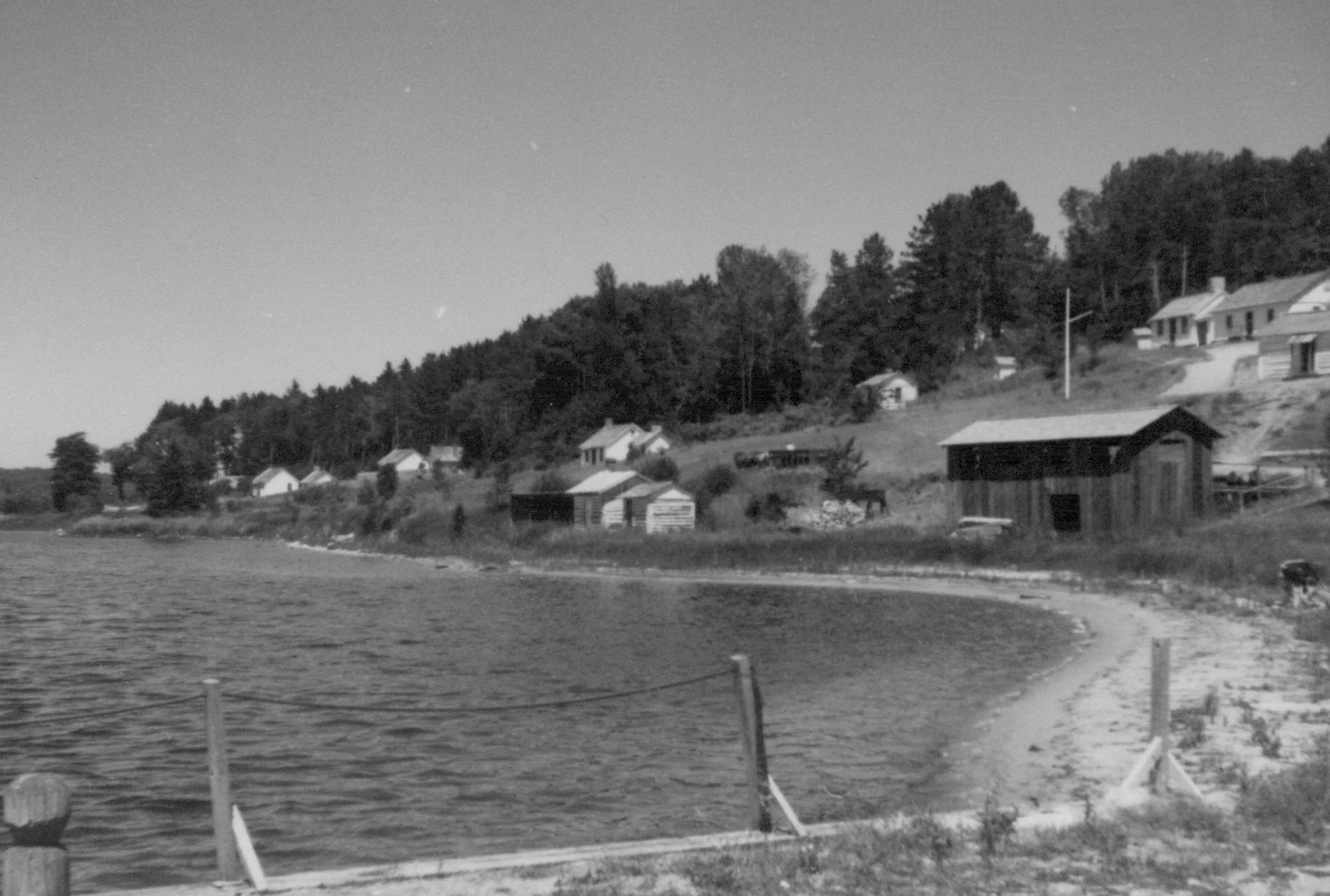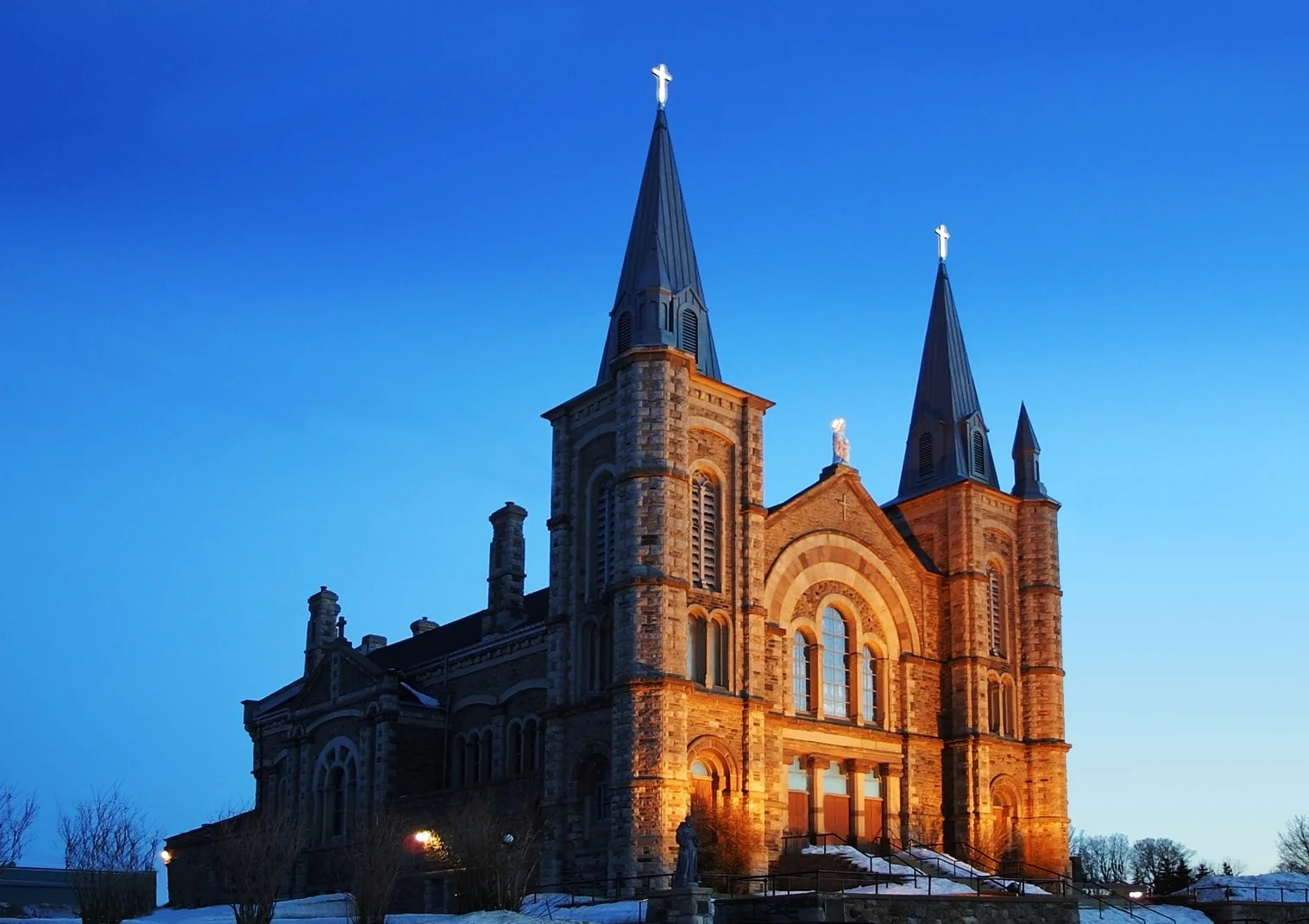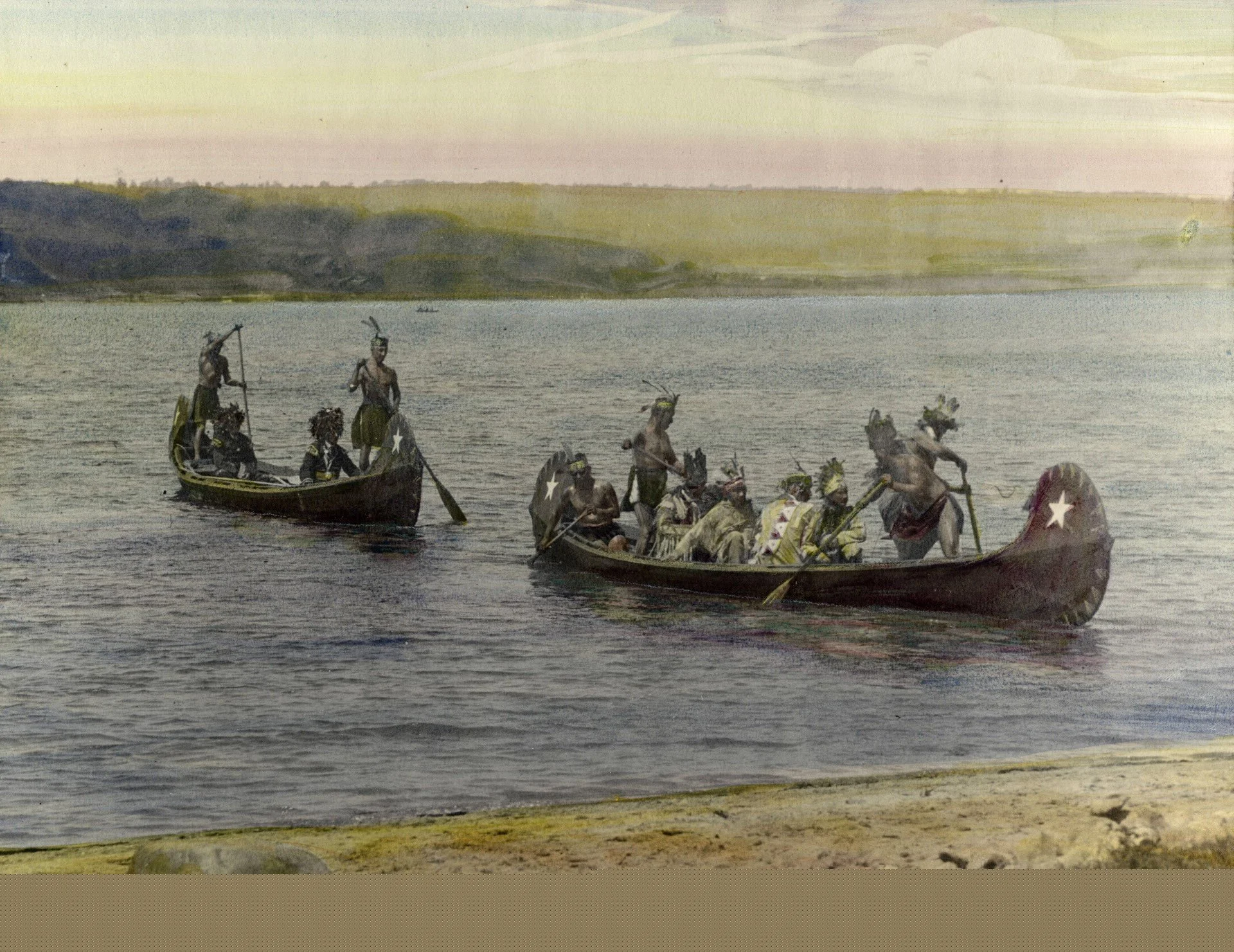“Penetanguishene Heritage Day!” What makes her so special!
In Penetanguishene in 1921 during the Old Home Week Celebrations, marking the 300th anniversary of Champlain’s landing here, Iroquois Grand chief Andre Staats from New York (front L) accompanies Huron-Wendat Grand Chief Ovide Sioui from Lorette, Quebec (front R), to the burying of a war hatchet ceremony in Huronia Park on Fox St. It would mark the first official “peace” between the two First Nations in over 300 years. Behind them are the head Sachems of the Mohawk, Oneidas, Onondaga, Cayuga and Senecas of the Iroquois confederacy and a sub-chief from the Huron-Wendat. All was orchestrated by Father Athol Murray, who conceived and coordinated the unveiling of Penetanguishene’s “Angels” of Peace, at which the above chiefs, hundreds of the area’s First Nations, and thousands of locals, attended.
For the past year, I have been working with an amazing and gifted man named Alexander “Alex” Roman, to create a private member’s bill to create a “Penetanguishene Heritage Day” to be celebrated every August 1st in Ontario. A lofty and ambitious goal we admit, but very doable and very appropriate, especially with a man in our corner with the knowledge, background and credentials that Alexander Jean de Brebeuf Roman possesses! Yes, Jean de Brebeuf is his middle name.
Born on the 16th concession near Lafontaine, Alex grew up in a very devout Catholic family that regularly attended mass at St. Anne’s Jesuit Memorial Church in Penetanguishene. It had a lasting effect on his faith which he took with him when his family moved away. He comes back to visit her every summer.
In 2006, a delegation from Penetanguishene including Yvon Gagne, Peter Hominuk, and myself, met with MPP Garfield Dunlop and Alexander Jean de Brebeuf Roman, Assistant to the Speaker, front right. It marked our first meeting to “Save Champlain’s Cross.” It would be the beginning of the eventual creation of Rotary Champlain-Wendat Park at the waterfront in 2015.
I first met “Alex” in 2006 at Queen’s Park through our local MPP at the time, Garfield Dunlop. We had formed a small local committee chaired by my brother-in-law, Yvon Gagne, and Garfield was part of a campaign to help save Champlain’s Cross on Penetanguishene Bay. The latest cross had fallen and was laying rotten on the ground at Toanche at the time. Garfield was trying to get us to meet the proper connections in the government. Alex was one of them and I gave him a copy of my large book on St. Anne’s. To say a friendship was sealed would be an understatement.
Now here we are together, trying to create a lasting legacy that would do, as Father Athol Murray said in 1975, “Recognize that Penetanguishene is the nucleus of Canada’s identity and the community should mobilize all of its efforts to that objective.”
So what makes Penetanguishene so special? How can Penetanguishene dare to say it represents the history and heritage of Ontario, and even Canada, for that matter? Actually, quite easily. Here is a short list of Penetanguishene milestones that has been included as “background” to accompany the bill for hopefully, three readings and Royal Assent:
______________________________________
“Indeed, Penetanguishene, located on the shores of Georgian Bay in present-day Simcoe County, has been touched by every aspect of Ontario and Canadian history and makes it unique.
Geological importance – The Penetanguishene Peninsula, on southern Georgian Bay, is where the massive rock formation, “The Canadian Shield,” stops in Southern Ontario. In 1855, surveyor, Sir Sanford Fleming, would note Penetanguishene’s topography was evidence of ancient beaches and a large prehistoric lake.
“Penetanguishene,” meaning “Place of the White Rolling Sands,” named by visiting First Nations Abinaki, or occupying Ojibway tribes.
1600’s - The Huron-Wendat – move to this region from southern Ontario to escape the wrath of southern Iroquois cousins. The Huron-Wendat numbered 30,000, lived in longhouses, and consisted of five clans: the One White Lodge, Cord, Rock and the Deer Clan and the fifth, the Bear Clan, the largest of all, who occupied the Penetanguishene Peninsula.
1610-15 - Étienne Brulé, “Coureur de Bois,” is sent by Samuel de Champlain to explore the region and befriend the Huron-Wendat First Nation. He lives at the Bear clan village of Toanche, on Penetanguishene Bay. Brulé would eventually go on to discover all five Great Lakes.
July 28, 1615 - Récollets missionary, Joseph LeCaron, lands at Toanche, to be followed on August 1, by Samuel de Champlain, Governor of New France. He spends the winter in the region.
August 1624 – Jesuit missionaries Jean de Brébeuf and companions, land at Toanche and establish the first mission of St. Nicholas there.
Fall of 1792 – Sir John Graves Simcoe, Lieutenant Governor of Upper Canada, inspects the protected harbour of Penetanguishene Bay and finds it ideal for a Royal Naval base in a potential war with the Americans. He wrote: “Penetanguishene bids fair to become the most considerable town in Upper Canada as the passage to the northwest will be established here.”
1813-1828 - War of 1812 erupts, Penetanguishene grows as Naval Establishment of Upper Canada. Large blockhouse and various buildings and quarters are established as well as ships built and at the ready, ferrying supplies to southern British bases.
1822 – Admiral Henry Woolsey Bayfield, official naval surveyor and cartographer, used the Naval Establishments at Penetanguishene as his headquarters to survey Georgian Bay and its ‘thousands of islands, measurements used to this day.
1825 – Sir John Franklin, British explorer, assembles his second polar expedition here, writing to his wife, “Penetanguishene is the most northerly of our naval stations and the key to Lake Huron.”
The Naval Establishment of Upper Canada at Penetanguishene grows with the influx of the military.
1828-1856 – The British Military Establishment succeeds the naval establishment and grows to include the 68th Royal Regiment and construction of permanent stone buildings such as the Officer’s Quarters.
1825- St. Anne’s Roman Catholic parish established, stretches from Manitoulin Island in the west, Penetanguishene, Port Severn in the north, Barrie in the east and to Owen Sound in the south.
1828 – large influx of Métis settles in and around Penetanguishene from Drummond Island and settlers from Québec
1830-1840s – the annual Fur Trade, Penetanguishene becomes the center of the Georgian Bay – central Ontario fur trade with bidders traveling from Montreal, New York, Australia and Europe.
1856 – Sir John A. MacDonald signs legislation to establish Boy’s Reformatory here.
1820s-1887 – the northern railroad and several sawmills, establish Penetanguishene as the center of the area lumber trade.
1875- Penetanguishene becomes an official “village.”
1882- Penetanguishene becomes an official “Town.”
St. Anne’s Jesuit Memorial Church, opened in 1902 as Canada’s National Shrine, as she looks today with her majestic spires.
1886-1902 –St. Anne’s Jesuit Memorial Church, Canadian National Shrine, constructed with funding from Canadian and French bishops, Vatican representatives, the Senate of France and Congress of the United States. Official opening had archbishops of Toronto and Kingston along with bishops of London and Peterborough.
1889- The grand Hotel Penetanguishene, opens with 150 guest rooms on two floors. It would host prime ministers and members of European royalty and have an orchestra play through meal hours.
1892- Island Legend of Giant’s Tomb – Penetanguishene “The Legend of Kitchikewana,” first published in late 1940s at Penetanguishene Winterama – the oldest winter carnival in Ontario.
1915-1918 – Stanley Cups, hockey brothers George, Harold and Howard McNamara and Bert Corbeau win Stanley Cups. Bert’s brother Con Corbeau plays in Stanley Cup finals.
Iroquois and Huron-Wendat chiefs arrive by canoe in 1921 for Peace treaty and burying of war hatchet.
1921 – Father Athol Murray, organizes Tercentenary celebrations of Champlain landing. Official ceremony of peace attended by Huron-Wendat chiefs from Quebec and Iroquois chief from US. Quebec and Ontario angels also unveiled at entrance to town.
1928 – long distance female runner Jean Thompson, a member of “The Matchless Six,” breaks world record and wins 800-yard Canadian long-distance championship, and helps Canada win Olympic track and field championship over US.
1939-1945 - Grew Boats, builds several Fairmile submarine chasers built for WW2 and launched here in Penetanguishene.
1944- The “Penetang,” - a 301 ft. 1,445 ton “River-Class” anti-submarine frigate christened into service
1942-47 – Philip “Babe” Marchildon, pitches 185 winning baseball games with the American League, Philadelphia Athletics. Later, inducted into Canadian Baseball Hall of Fame.
1952 - Jockey Gil Robillard, wins the first Queen’s Plate at Woodbine Racetrack aboard “Epigram.”
1959 – Queen Elizabeth and Prince Phillip visit Penetanguishene aboard Royal Yacht, Britannia.
1975. Monsignor Athol Murray returns to Penetanguishene to bless and “rededicate” his angels.
1975 - Father Athol Murray - a recipient of The Order of Canada and Inductee to the Hockey Hall of Fame, returns to bless and unveil, the new “angels.”
1987 – figure skater Brian Orser and the Russ Howard curling team, win world championships.
1987-2022, Glenn Howard, would win 4 world curling championships, 4 Briers and 17 Ontario Tankard provincial championships. He has played in more games than any curler in history.at that time.
August 1, 2015 - Rotary Champlain-Wendat Park, unveiled by Premier Kathleen Wynne and representatives of the Huron-Wendat Nation from Quebec, recognized and planned with many First Nations statues and symbols, signifying a park of reconciliation.”
This is what makes Penetanguishene worthy of such provincial and federal recognition!
Mike drop!






